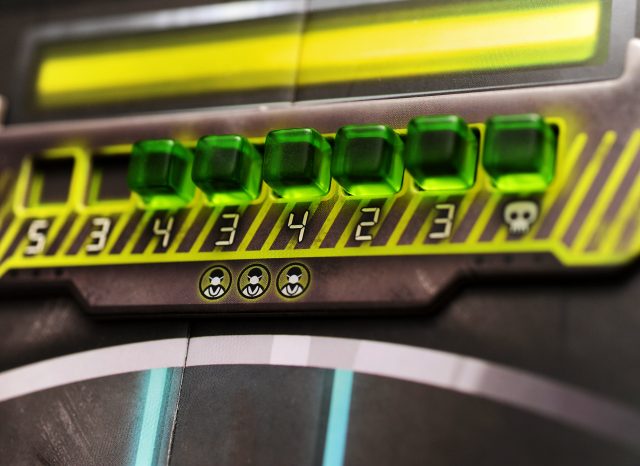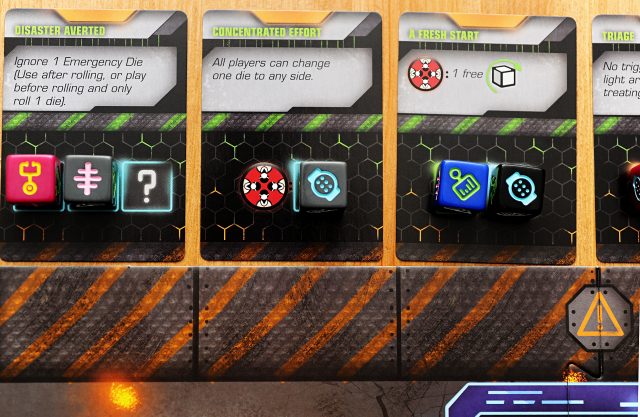The bomb defusal team did just enough in FUSE to make sure the crew survived – and now, in Flatline (A FUSE Aftershock Game), you’re the team in the med bay trying to make sure everyone who made it through the attack survives. No pressure! Haha.. Well, yes pressure. However unlike FUSE and many other real time co-operative games, Flatline measures out that pressure and creates a rewarding gameplay experience. Can you treat all those patients before you run out of power – and time?
While FUSE was a fairly straight forward co-op dice rolling extravaganza, Flatline has a little more going on for those of us that want a bigger picture and some more stresses to juggle. Fun stresses, of course. Each round of Flatline brings out “emergency” and “STAT!” cards (the number of which depends on the power level you’re at), and provides 4 patients for you to work on saving. On top of this, you’ve got the power level of the station slowly dropping to keep an eye on and try and mitigate. No biggie! It’s fine trying to sew those people up while things are falling down left, right and center. So – beyond helping patients and trying to not be all “oh god oh god we’re all gonna die”, how does Flatline really play out and how do all these elements work together?
Dice madness, is how. Not quite the aforementioned extravaganza of FUSE, but the primary mover and shaker for the players here are the gorgeous custom dice. Each player will control a set (or in a solitaire game, you control 2) and after the setup of each round, you’ll be rolling these dice and have a minute to count down and do your best to triage some pretty tough situations – not to mention patch up those patients. This was a key part of enjoying Flatline for me – not just being thrust into rolling frantically, but getting to assess the situation before leaping in to assign those dice. Just like I imagine any ER would be – especially one falling down around your ears – you have to step back and take stock and assign your resources where they are needed most, for the greater good. And watch that lineup of patients not get any smaller..
Before you get anywhere near that lineup, you’ll need to set up the board pre-countdown. First you’ll lose a power marker – this track is a really neat way of  tracking the game’s progression, and it also switches up the challenge level from round to round, with different amounts of cards hitting the med bay depending on how much or little power you have. As one of the game’s lose conditions is hitting zero power, this can be pretty important to keep an eye on, and can be tough to keep up with. Fiendish little green cubes. If you can manage to assign dice to the two recharging stations on the board and time it nicely, it can prolong your game and also help you manage how many emergency cards you’ll expect for the next round.
tracking the game’s progression, and it also switches up the challenge level from round to round, with different amounts of cards hitting the med bay depending on how much or little power you have. As one of the game’s lose conditions is hitting zero power, this can be pretty important to keep an eye on, and can be tough to keep up with. Fiendish little green cubes. If you can manage to assign dice to the two recharging stations on the board and time it nicely, it can prolong your game and also help you manage how many emergency cards you’ll expect for the next round.
What’s that? What could any med bay need but more emergencies? Terrific! These come out off a deck – blue tabbed cards head to the 6 slots in the regular emergency section of the board and orange tabbed cards head to the stat section of the board. The latter are more immediate concerns that need to be resolved that turn, or they’ll be a mark against your team (and if you hit a certain number, the game is lost). The regular emergency cards are activated by rolling 2 six sided dice, and the cards corresponding to those numbers are active for the turn giving you some tricky obstacles to work around. Stat cards are pretty tough and can really take your focus off patients, but if you resolve them they become one-time “triage” cards with a number of helpful effects (for instance, each player gaining an extra die, ignoring emergency cards, helping to heal a patient, gaining power back & more) so it’s not all terrible. Just enough hope to keep you going for the patients.
So, how about those patients.. *checks the chart* There will be 4 on the board for treatment at any time, and there’s no limitations on treating them in any order – and you can work on multiple patients at the same time. The only restriction are the assignment icons next to each line on the patient card – that either only 1, exactly 2, more than 2 or every player must contribute to a certain line. This means that the team can’t just throw matching dice anywhere – and where the quick planning before this phase can really help you make the most of the minute you have. Depending on how lucky your dice rolls are, you may end up with some slow progression on getting patients out of there into recovery, so I highly recommend playing at the “training” level for your first game to really get a handle on everything without feeling like that stack of patients isn’t getting any smaller.
After the countdown and everyone’s serious and furious dice placing is done, you’ll need to take a look around the board and resolve each sector. It’s key here to pay  close attention to the flow of the round, and take the advice of the rules which suggest having a couple of people take responsibility for certain things like handling removal of dice, moving cards around and so on. If it gets out of order it could be confusing and you might end up missing out on something great or maybe even accidentally un-treating a patient. Resolve your stat and emergency cards and then any completely treated patients. It’s here that the life support dial adds another dimension to keep an eye on. Treating a patient completely triggers and effect based on the dial’s position. We honestly didn’t feel like this held us up at all, except for just not getting the cool stuff we wanted because of rolling the wrong dice to complete a certain patient. If you’ve not completed treating all your patients at this point, rotate the life support wheel and continue on – otherwise, congratulations! Those are some happy, alive folks you’ve got there. You deserve a break.
close attention to the flow of the round, and take the advice of the rules which suggest having a couple of people take responsibility for certain things like handling removal of dice, moving cards around and so on. If it gets out of order it could be confusing and you might end up missing out on something great or maybe even accidentally un-treating a patient. Resolve your stat and emergency cards and then any completely treated patients. It’s here that the life support dial adds another dimension to keep an eye on. Treating a patient completely triggers and effect based on the dial’s position. We honestly didn’t feel like this held us up at all, except for just not getting the cool stuff we wanted because of rolling the wrong dice to complete a certain patient. If you’ve not completed treating all your patients at this point, rotate the life support wheel and continue on – otherwise, congratulations! Those are some happy, alive folks you’ve got there. You deserve a break.
While there are a few illustrations in the game, most of the art is fairly abstracted and space-y. The iconography is really strong, which makes a huge difference in the leap from learning the game to remembering how everything works and flows while you’re playing it – for a game with a lot going on, the graphic design team really got that right. I mentioned the gorgeous custom etched dice earlier, which are a dream to roll and their icons are clear and easy to identify quickly for matching. As well as that, the cardboard for the life support wheel and patient cards and the like is nice and chunky and gives some weight to the game which makes everything stay fairly well put as you’re hurrying to get dice down on everything. On top of this all, Renegade’s companion app (for iOS and Android) has functionality for Flatline. There’s a link to learn how to play which is great! It also helps you through the steps of the round which can definitely help minimize some of the confusion I mentioned above – plus it’s got some pretty spacey beats for action background music during the 1 minute countdown.
If you love co-operative games with some tension and gameplay that’s not over too quickly, this could be up your alley. I know a lot of folks who can be put off by frantic real-time play too, but it’s nice that it’s more of a punctuation to the flow of the game rather than the entire game, itself. Somewhere between Fuse, Pandemic: The Cure & Doctor Panic, Flatline will not necessarily offer any surprises when you replay but it will be different enough to be enjoyable and a great co-op challenge every time it hits the table.
Quick! 400ccs of cardboard and dice! STAT!
—
Thank you so much to Renegade Games for sending us Flatline to try. We really did hope to save all the patients. (Sorry!) Flatline plays 1 – 5 people in around 45 minutes and is available in stores now.
[…] on when it was entered. It’s right in the URL for the game. For example, Flatline (which Nicole just wrote about) is the 216597th game to be entered–which is pretty mind-blowing all by […]
[…] have already published several more fine games (including Flatline, which Nicole just wrote about last month). In the next month or so they will release two excellent card games: The Fox in the Forest, which […]